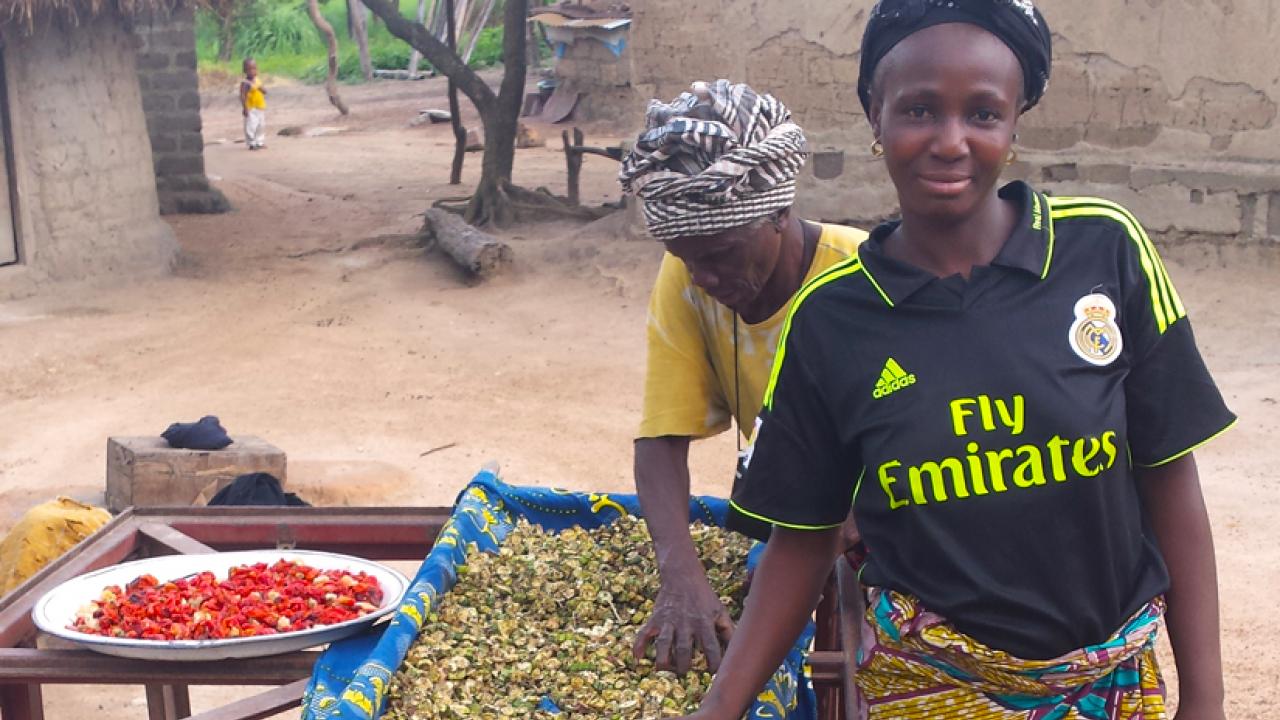
In the wake of the Ebola outbreak, the U.S. Agency for International Development provided funding to the Horticulture Innovation Lab to assess horticulture value chains in Guinea, to identify constraints of improving fruit and vegetable production at household and commercial levels.
Developing the horticulture sector in Guinea is an important part of improving the capacity of smallholder farmers to grow, eat, and sell fruits and vegetables. Increasing household and commercial production, marketing, and storage of horticultural crops leads to diversified cropping systems, diversified diets, and greater resiliency.
Highlights from the report are below. You may also be interested in reading:
- Blog post: "New report on horticulture in Guinea, after Ebola"
- Report PDF: "Rapid Assessment of the Horticulture Sector in Guinea"
What we did
From May to September 2015, the Horticulture Innovation Lab’s team conducted a desk study, interviewed stakeholders, and surveyed farmers, village leaders and market traders in four zones of Southern Guinea. The rapid assessment was designed to provide guidance and recommendations of activities that can improve Guinea’s horticultural sector. The resulting report considers farmers, institutions and markets while looking at the entire sector from seed systems to markets, with special consideration paid to gender and nutrition.
What we found
The assessment uncovered several interesting factors among the country’s existing horticulture.
Horticulture and markets: In general, horticultural production decreased with distance from Conakry’s metropolitan markets, but farmers also access well-established weekly regional markets and even travel to Sierra Leone or Liberia to sell extra produce. Farmers were motivated to sell whenever they had extra produce, with even the poorest renting a car or riding a bus long distances to sell.
Gender: Women in Guinea grow a lot of vegetables and face constraints to purchasing agricultural inputs. But men and women exchange information related to their horticultural efforts, offering opportunities for improvement and success. In Guinea, a woman’s horticultural production often becomes more sophisticated as her husband’s horticultural practices improve. Men reported valuing what women know, including what women learn from selling vegetables in markets such as new seed varieties to try.
Wealth, labor and groups: Access to labor and equipment is central to how Guineans measure wealth, so participating in groups (groupements) was important to the farmers and marketers interviewed. Existing group structures offer opportunities for implementing savings groups or specialized groups focused on processing and postharvest handling of horticultural crops.
Training opportunities: Across the horticulture sector, we discovered that great gains could be made by investing in nutrition training, postharvest processing and food preservation. Farmers who succeed at horticultural production would benefit from training in postharvest handling, packaging and storage. Consumers would benefit from having access to better stored and better processed foods. Supporting crop diversification, investing in the seed system, and scaling up labor-saving technologies would strengthen the horticulture sector across all wealth classes, genders, and zones.
What we recommend
A horticulture sector strategy that intentionally prioritizes rural revitalization — one that empowers individual communities to take control over their livelihoods and create their own opportunities for agricultural investment and growth — is a strategy that would find support and success in rural Guinea.
Horticulture sector recommendations
- Inputs: Facilitate access to loans or small grants and support seed production (research- or field-level) and seed banking techniques.
- Production: Promote simplified and sustainable farming techniques, conservation agriculture practices in horticulture, and basic fencing and animal husbandry practices to protect gardens.
- Pest management: Train agricultural extensionists in pest identification and provide training to farmers in the five components of integrated pest management.
- Credit: Create partnerships with local banks and with bankers who understand horticulture and support savings groups.
- Entrepreneurship and marketing: Promote the standardization and marketing of horticultural products, develop and reinforce technical exchange and support among horticulture actors, support training in basic agro-entrepreneurship skills and postharvest techniques, invest in simplified postharvest technologies, develop farmers’ skills in record keeping, and conduct market research to support local agribusinesses.
- Postharvest: Provide training in basic postharvest practices; set up collection centers; and support smallholder processing of mango, avocado, banana, tomato and eggplant.
- Nutrition: Support interventions in household gardening along with nutrition counseling, education and behavior change communication; and take a broad, community-level approach to nutrition.
- Policy: Support the development of government policies in horticulture that create market opportunities for smallholders; support governments in setting minimum standards for the importation and sale of fertilizers, pesticides, seeds and other inputs; and provide opportunities for policy makers to attend regional workshops and conferences on creating a competitive, private sector-led fertilizer and input industry.
- Human and institutional capacity development: Develop the extension system in Guinea through strengthening the national extension system, Direction Nationale d’Agriculture, and investing in extensionists.
Recommendations for horticultural crops
- Chili pepper: Develop a seed marketing initiative, provide training in good agricultural practices (GAPs), build linkages between growers and international markets, and improve the processing.
- Okra: Increase support of production and drying.
- Eggplant: Improve irrigation for dry-season production, improve the quality and availability of fertilizers in local markets, and support research on better production and postharvest practices.
- Tomato: Support research and testing of new varieties and pest management strategies; develop Guinean institutional capacity to design and implement GAPs for tomato; and invest in postharvest interventions of shade, packaging, and processing.
- Mango: Support integrated pest management strategies for fruit flies, facilitate the dissemination of improved varieties, and invest in postharvest handling and storage and processing.
- Oranges: Support research in pests of oranges and orange trees.
The assessment also included recommendations specifically targeting women farmers, farmers by wealth quartile (wealthier, middle-income, poor, poorest), and farmers in four specific geographic zones (FEWS NET Livelihood Zones GN 02, 03, 09 and 10).
More information is available in the report, "Rapid Assessment of the Horticulture Sector in Guinea" (PDF).
You may also be interested in our blog post about the creation of the report, its goals, and highlights, "New report on horticulture in Guinea, after Ebola" from December 2015.
